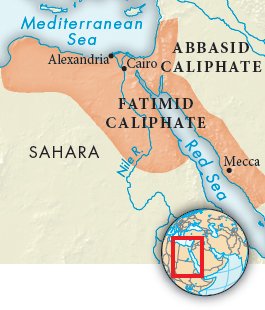Breakaway Territories and Shi’a Gains

One of the first territories to break away from the Baghdad-
In 946 a Shi’a Iranian clan overran Iraq and occupied Baghdad. The caliph was forced to recognize the clan’s leader as commander in chief and to allow the celebration of Shi’a festivals. A year later the caliph was accused of plotting against his new masters, snatched from his throne, dragged through the streets, and blinded. This incident marked the practical collapse of the Abbasid caliphate. Abbasid caliphs, however, remained as puppets of a series of military commanders and symbols of Muslim unity until the Mongols killed the last Abbasid caliph in 1258 (see “The Mongol Invasions”).
In another Shi’a advance, the Fatimids, a Shi’a dynasty that claimed descent from Muhammad’s daughter Fatima, conquered North Africa and then expanded into the Abbasid province of Egypt, founding the city of Cairo as their capital in 969. For the next century or so, Shi’a were in ascendancy in much of the western Islamic world.